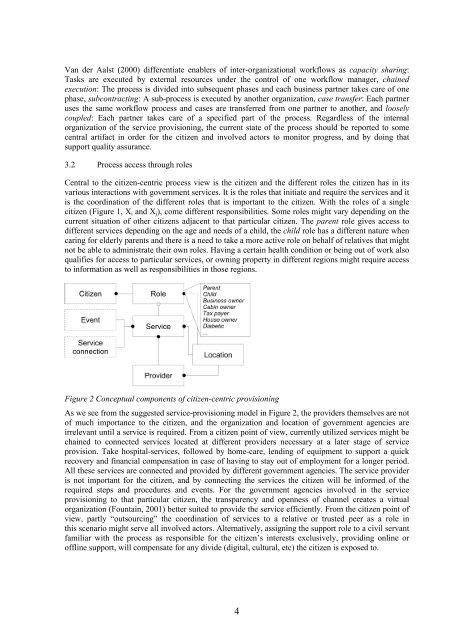Multi-channel provisioning of public services - Department of ...
Multi-channel provisioning of public services - Department of ...
Multi-channel provisioning of public services - Department of ...
Create successful ePaper yourself
Turn your PDF publications into a flip-book with our unique Google optimized e-Paper software.
Van der Aalst (2000) differentiate enablers <strong>of</strong> inter-organizational workflows as capacity sharing:<br />
Tasks are executed by external resources under the control <strong>of</strong> one workflow manager, chained<br />
execution: The process is divided into subsequent phases and each business partner takes care <strong>of</strong> one<br />
phase, subcontracting: A sub-process is executed by another organization, case transfer: Each partner<br />
uses the same workflow process and cases are transferred from one partner to another, and loosely<br />
coupled: Each partner takes care <strong>of</strong> a specified part <strong>of</strong> the process. Regardless <strong>of</strong> the internal<br />
organization <strong>of</strong> the service <strong>provisioning</strong>, the current state <strong>of</strong> the process should be reported to some<br />
central artifact in order for the citizen and involved actors to monitor progress, and by doing that<br />
support quality assurance.<br />
3.2 Process access through roles<br />
Central to the citizen-centric process view is the citizen and the different roles the citizen has in its<br />
various interactions with government <strong>services</strong>. It is the roles that initiate and require the <strong>services</strong> and it<br />
is the coordination <strong>of</strong> the different roles that is important to the citizen. With the roles <strong>of</strong> a single<br />
citizen (Figure 1, X i and X j ), come different responsibilities. Some roles might vary depending on the<br />
current situation <strong>of</strong> other citizens adjacent to that particular citizen. The parent role gives access to<br />
different <strong>services</strong> depending on the age and needs <strong>of</strong> a child, the child role has a different nature when<br />
caring for elderly parents and there is a need to take a more active role on behalf <strong>of</strong> relatives that might<br />
not be able to administrate their own roles. Having a certain health condition or being out <strong>of</strong> work also<br />
qualifies for access to particular <strong>services</strong>, or owning property in different regions might require access<br />
to information as well as responsibilities in those regions.<br />
Figure 2 Conceptual components <strong>of</strong> citizen-centric <strong>provisioning</strong><br />
As we see from the suggested service-<strong>provisioning</strong> model in Figure 2, the providers themselves are not<br />
<strong>of</strong> much importance to the citizen, and the organization and location <strong>of</strong> government agencies are<br />
irrelevant until a service is required. From a citizen point <strong>of</strong> view, currently utilized <strong>services</strong> might be<br />
chained to connected <strong>services</strong> located at different providers necessary at a later stage <strong>of</strong> service<br />
provision. Take hospital-<strong>services</strong>, followed by home-care, lending <strong>of</strong> equipment to support a quick<br />
recovery and financial compensation in case <strong>of</strong> having to stay out <strong>of</strong> employment for a longer period.<br />
All these <strong>services</strong> are connected and provided by different government agencies. The service provider<br />
is not important for the citizen, and by connecting the <strong>services</strong> the citizen will be informed <strong>of</strong> the<br />
required steps and procedures and events. For the government agencies involved in the service<br />
<strong>provisioning</strong> to that particular citizen, the transparency and openness <strong>of</strong> <strong>channel</strong> creates a virtual<br />
organization (Fountain, 2001) better suited to provide the service efficiently. From the citizen point <strong>of</strong><br />
view, partly “outsourcing” the coordination <strong>of</strong> <strong>services</strong> to a relative or trusted peer as a role in<br />
this scenario might serve all involved actors. Alternatively, assigning the support role to a civil servant<br />
familiar with the process as responsible for the citizen’s interests exclusively, providing online or<br />
<strong>of</strong>fline support, will compensate for any divide (digital, cultural, etc) the citizen is exposed to.<br />
4
















